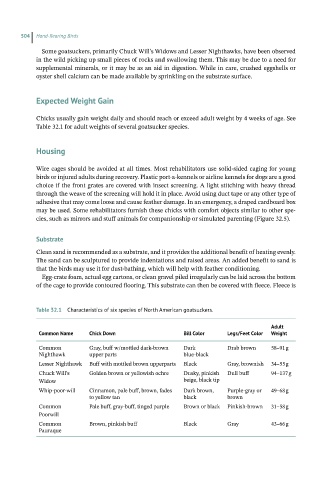Page 507 - Hand rearing birds second
P. 507
504 Hand-Rearing Birds
Some goatsuckers, primarily Chuck Will’s Widows and Lesser Nighthawks, have been observed
in the wild picking up small pieces of rocks and swallowing them. This may be due to a need for
supplemental minerals, or it may be as an aid in digestion. While in care, crushed eggshells or
oyster shell calcium can be made available by sprinkling on the substrate surface.
Expected Weight Gain
Chicks usually gain weight daily and should reach or exceed adult weight by 4 weeks of age. See
Table 32.1 for adult weights of several goatsucker species.
Housing
Wire cages should be avoided at all times. Most rehabilitators use solid‐sided caging for young
birds or injured adults during recovery. Plastic port‐a‐kennels or airline kennels for dogs are a good
choice if the front grates are covered with insect screening. A light stitching with heavy thread
through the weave of the screening will hold it in place. Avoid using duct tape or any other type of
adhesive that may come loose and cause feather damage. In an emergency, a draped cardboard box
may be used. Some rehabilitators furnish these chicks with comfort objects similar to other spe-
cies, such as mirrors and stuff animals for companionship or simulated parenting (Figure 32.5).
Substrate
Clean sand is recommended as a substrate, and it provides the additional benefit of heating evenly.
The sand can be sculptured to provide indentations and raised areas. An added benefit to sand is
that the birds may use it for dust‐bathing, which will help with feather conditioning.
Egg‐crate foam, actual egg cartons, or clean gravel piled irregularly can be laid across the bottom
of the cage to provide contoured flooring. This substrate can then be covered with fleece. Fleece is
Table 32.1 Characteristics of six species of North American goatsuckers.
Adult
Common Name Chick Down Bill Color Legs/Feet Color Weight
Common Gray, buff w/mottled dark‐brown Dark Drab brown 58–91 g
Nighthawk upper parts blue‐black
Lesser Nighthawk Buff with mottled brown upperparts Black Gray, brownish 34–55 g
Chuck Will’s Golden brown or yellowish ochre Dusky, pinkish Dull buff 94–137 g
Widow beige, black tip
Whip‐poor‐will Cinnamon, pale buff, brown, fades Dark brown, Purple‐gray or 49–68 g
to yellow tan black brown
Common Pale buff, gray‐buff, tinged purple Brown or black Pinkish‐brown 31–58 g
Poorwill
Common Brown, pinkish buff Black Gray 43–66 g
Pauraque

